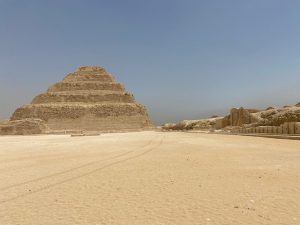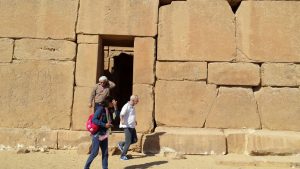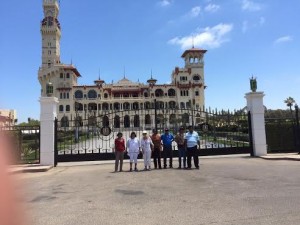private guided tour to Saqqara
Private guided tour to Saqqara
Martine Jardel contacted me to arrange a private guided tour to Saqqara. I asked her if she preferred to do the tour as a full-day or half-day experience. We purchased the all-inclusive ticket to the site since she chose a full-day tour.

Imhotep Museum
We visited the Imhotep Museum which was built thanks to the teamwork of Jean-Philippe Lauer, the French Egyptologist who dedicated a significant part of his life to Saqqara. This museum showcases objects he discovered at the site and highlights the architecture before the time of Pharaoh Djoser. The museum features, a list of Egyptologists who worked on the site, along with a map illustrating the various historical eras of the site of Saqqara.
In Saqqara, you can find the pyramids of the pharaohs and the mastabas of nobles and prominent figures who held prestigious titles.
In most of these mastabas, we can observe scenes depicting daily life in that era, notable for their exceptional preservation and the vivid quality of their colours.
We visited the Djoser complex and its iconic step pyramid which had been closed by the Egyptian government for many years but was recently reopened, it now highlights Djozer’s groundbreaking architectural innovation: the first known attempt at large-scale stone construction.

the Mortuary Temple and Pyramid of Pharaoh Unas
It is considered the “Beautiful are the places of Unas,” dating back to the Fifth Dynasty of the Old Kingdom. It is the first pyramid to be adorned with religious texts.
During this private day tour to Saqqara, we had the opportunity to visit the tomb of the “Two Brothers” Niankhkhnum and Khnumhotep, they were royal hairdressers, overseers of manicures at the palace, and trusted confidants of the pharaoh. The tomb was discovered in 1964 by an Egyptian archaeologist Ahmed Moussa.
Next door, we find the tomb of the Butchers discovered in 1940, with its 14 statues.
We made sure to visit the necropolis of the bulls, which we consider one of Saqqara’s great enigmas due to its exceptional and unique construction, unparalleled anywhere in the world. This site was discovered by Auguste Mariette in 1851 and was later closed by the Egyptian authorities for 15 years for restoration.
The necropolis houses 24 massive sarcophagi made of Aswan granite, each weighing between 60 and 80 tons. This cemetery is dedicated to the cult of the Apis bull, considered the living manifestation of the god ptah, the local deity of Memphis, which was the first capital of pharaonic Egypt.
We marvelled at how the ancient Egyptians managed to transport and fit these enormous sarcophagi into the tombs, curved granite with such precision, and whether these sarcophagi served a funerary purpose or had another, perhaps symbolic function.
We also visited Mehu’s tomb, discovered by Zakie Saad in 1940 and recently opened to visitors. Mehu was a vizier of Pharaoh Pepi I and held 48 prestigious titles. This tomb, dating back to the 6th Dynasty, consists of four rooms, beautifully decorated with vibrant colours and rich scenes depicting the daily life of the time.. Then, Next, we explored the mastaba of Mereruka, discovered by Jacques Morgan in 1892 and opened to the public in 1912. Mereruka also held numerous titles, including Minister of Justice, Prime Minister, and High Priest. As the son-in-law of Pharaoh Teti, he was the most powerful individual after the pharaoh. The tomb features remarkable fishing, hunting, farming, and craftsmanship scenes.
 We finally visited the pyramid of Teti, the tombs of Kagemni, the tomb of Ti, and the mastaba of Idut.
We finally visited the pyramid of Teti, the tombs of Kagemni, the tomb of Ti, and the mastaba of Idut.
Martine concluded that a private guided tour was essential to fully explore the richness of the Saqqara site.


 Back to work as a private tour guide in
Back to work as a private tour guide in 
 The forgotten desert of Faiyum is located north of
The forgotten desert of Faiyum is located north of 

 Then, if we continue in the desert 8 km north of Qarun Lake, we will find ”Qasr elsagha”, an unfinished limestone construction discovered by Schweinfurth composed of 7 shrines dating back to the
Then, if we continue in the desert 8 km north of Qarun Lake, we will find ”Qasr elsagha”, an unfinished limestone construction discovered by Schweinfurth composed of 7 shrines dating back to the 

 opera that represents the ancient Egyptian history, the French archaeologist
opera that represents the ancient Egyptian history, the French archaeologist



 At the time of Ramses II, the long driveway was discovered and throughout its 80m on each side, one could stop to pray and give offerings in multiple chapels covered with votive offerings that bordered it.
At the time of Ramses II, the long driveway was discovered and throughout its 80m on each side, one could stop to pray and give offerings in multiple chapels covered with votive offerings that bordered it.






 Nefertiti Queen of Egypt, “which means the beautiful is coming” is a legendary beauty, she is the wife of Pharaoh Akhenaten (Amenhotep IV), and the stepmother of the Pharaoh Tutankhamun, because of her name, there is a doubt that she is a foreigner.
Nefertiti Queen of Egypt, “which means the beautiful is coming” is a legendary beauty, she is the wife of Pharaoh Akhenaten (Amenhotep IV), and the stepmother of the Pharaoh Tutankhamun, because of her name, there is a doubt that she is a foreigner. Nefertiti and Akhenaten created a new artistic style; absolute freedom was given to the artist, he could go inside the palace of the pharaoh and represent him in a real representation with his defaults (it was exceptionally) you can see them as a family with their daughters under the protection of the sun disk which sends its rays ending with hands that give life, Nefertiti and Akhenaten are intermediaries between this life and the people.
Nefertiti and Akhenaten created a new artistic style; absolute freedom was given to the artist, he could go inside the palace of the pharaoh and represent him in a real representation with his defaults (it was exceptionally) you can see them as a family with their daughters under the protection of the sun disk which sends its rays ending with hands that give life, Nefertiti and Akhenaten are intermediaries between this life and the people.
 Cairo and Alexandria visits with a private tour guide in Ramadan are still interesting and possible to be visited; you can still visit the touristic attractions such as Memphis, Sakkara, Giza pyramids, the Egyptian museum etc…, you just have to take care about the timing because all the touristic sites close one hour earlier, it means at 15 O’clock, instead of 16 O’clock.
Cairo and Alexandria visits with a private tour guide in Ramadan are still interesting and possible to be visited; you can still visit the touristic attractions such as Memphis, Sakkara, Giza pyramids, the Egyptian museum etc…, you just have to take care about the timing because all the touristic sites close one hour earlier, it means at 15 O’clock, instead of 16 O’clock.

